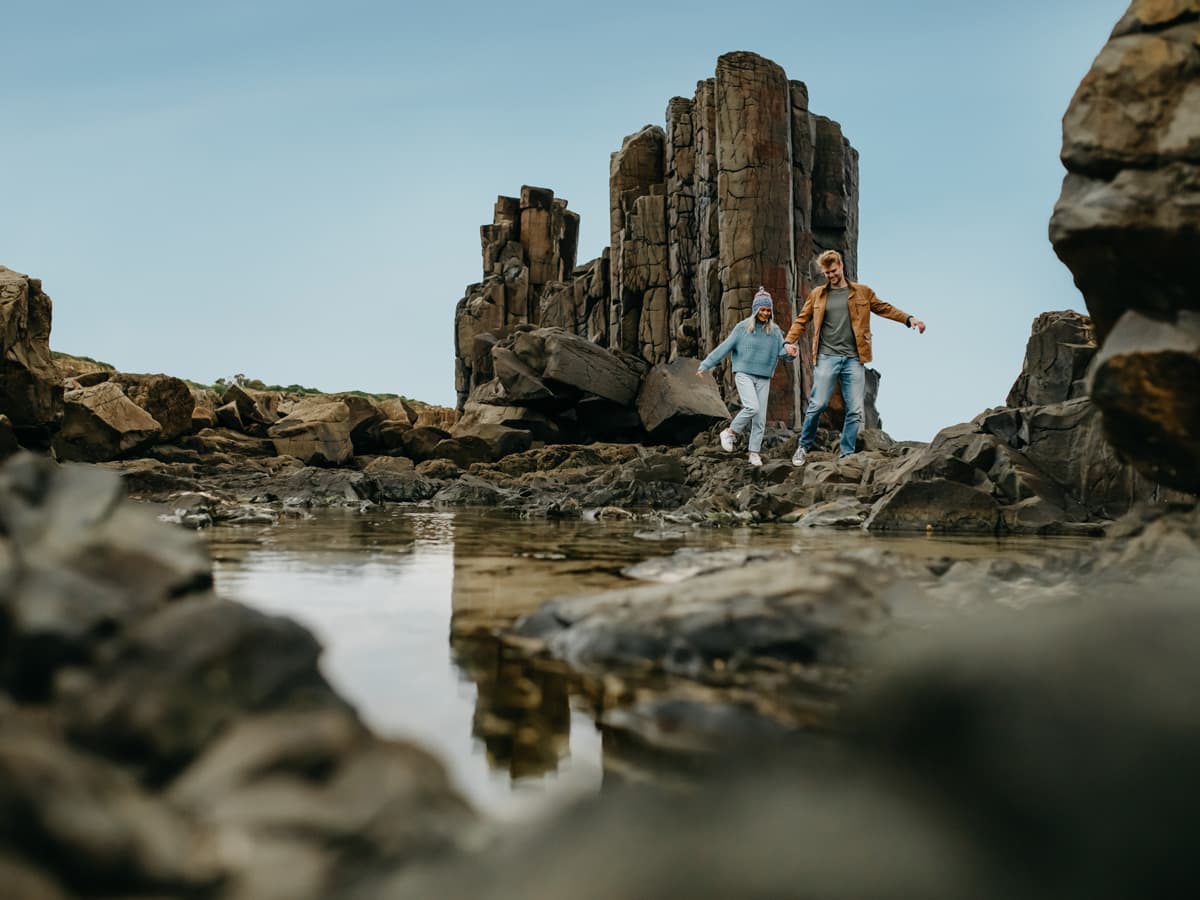04 July 2023
![]() 5 mins Read
5 mins Read

Hidden beaches, ancient rock formations, panoramic vistas, ocean blowholes and languid lagoons. It’s all waiting for you on the Kiama Coast Walk. There are three well-maintained sections to explore, suitable to most fitness levels. Take your lover, go with a mate, step out solo, or even bring the pooch along.
Stretching 20 kilometres from Kiama to Gerringong, the Kiama Coast Walk features dramatic seaside views, windswept headlands, and a stunning collection of picturesque beaches. The track is divided into three main sections, meaning you can make a day of it and gently hike for six to seven hours from start to end or keep a leisurely pace along your preferred walkway. There are ample places to stop and refuel too (try one of our recommended cafes).

Traverse the stunning beach path along Kiama. (Image: Destination NSW)
Distance: 8.5 kilometres
Time: three hours
Park your car (for free) at the start of the Minnamurra River aka Kiama Downs as the locals like to call it and begin your walk south.

Hop your way through the basalt formations at Bombo Quarry. (Image: Destination NSW)
Sightseeing highlights include; the heritage-listed Bombo Quarry with its spectacular basalt formations jutting up from the ocean floor, the dramatic volcanic structures that form Cathedral Rocks and the famous Kiama Blowhole. If you’ve had enough beauty for one day stroll back the way you came or catch the train from Kiama station to Minnamurra.

Catch Kiama Blowhole – the largest in the world. (Image: Destination NSW)
Distance: Five kilometres
Time: 1.5 hours
This is the shortest section of the Kiama Coast Walk and is suitable for those seeking a casual amble by the sea as opposed to a full-tilt, all-day hiking itinerary. Watch the surfers ride ‘The Wedge’ break before you head on down to the calm waters of Kendalls Beach for a swim. Kiama’s Little Blowhole is a gorgeous place to catch your breath, break for a rest and admire the scenery. Keep in mind that the Easts Beach stretch is a terrific family-friendly (seasonally patrolled) Kiama holiday zone.

Soak up scenic views from Kendalls Beach. (Image: Mark Fitzpatrick; Destination NSW)
Distance: Six kilometres
Time: Two hours
Beginning at Loves Bay (parking available on Elanora Road), the South Section is more popular with Gerringong residents. Approximately two hours into the walk you’ll come across Werri Lagoon, it’s an angler’s paradise so why not drop a line and see if you can catch a fish for tea? Didn’t hook anything? No problems, stay and have a feed at a nearby cafe, return and complete the walking track loop or charge ahead to Gerringong and train it home to Kiama.

Feel the sand beneath your toes at Werri Beach. (Image: Mark Fitzpatrick; Destination NSW)
There are many natural attractions on the Kiama Coast Walk, if you find time to see them all, that’s ace but if you need to prioritise your time, be sure to put the following unmissable highlights on your list asap: Mystic Beach, Cathedral Rocks, the Kiama Blowhole and the ocean pool at South Werri Beach.

Catch the sunrise at Cathedral Rocks. (Image: Tourism Australia)
Be prepared, sunscreen (an ocean-friendly brand is best), a hat, comfortable walking shoes and a bottle of H20 are musts. Depending on how far you plan on trekking, you might want to pack some nourishing snacks too. Oh, and swimmers, don’t forget those because there are plenty of lovely spots on the Kiama Coast Walk to stop for a dip and cool off.

There are plenty of beaches to take a dip in. (Image: Tourism Australia)
Hints: if you select the North Section for your walking adventure, we recommend wrapping up your hike with a refreshing beverage at the 19th hole aka the clubhouse at the Kiama Golf Course. Always keep your camera ready when traversing the Mid Section too, it’s here you can visit the Pilot’s Cottage Museum and take a few snapshots of history. Are you an early bird catches the worm type of person? If so, start your day at the South Section, the whale-watching platform is a beautiful place to watch the sunrise and enjoy a pre-packed breaky.

Step into Kiama’s rich historical heritage at Pilot’s Cottage Museum.
Dogs are allowed (on leash please) for most of the Kiama to Gerringong walk and there are even a few pet-friendly beaches (with off-leash areas) along the way too. Certain sections of the walk are bicycle friendly and there are well-maintained facilities such as free beachside BBQs, viewing platforms and drinking fountains located at many points of the walk for visitors to enjoy.
The Wodi Wodi are the First Nations custodians of the Illawarra region and many areas around Kiama, Gerringong and Bombo were considered good sources of “ochre” — a deep orange clay used for aboriginal ceremonies.
LEAVE YOUR COMMENT